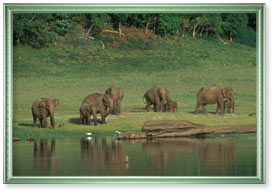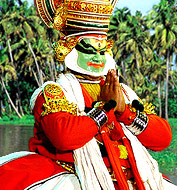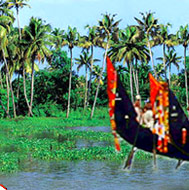 Kerala, nicknamed as God's Own Country, is a land of lively beaches, serene backwaters, and spectacular hill stations - all three oozing out a sense of awe-inspiring beauty. Add to this the virgin wildlife sanctuaries, flourishing as if God was personally keeping a watch over them, and we have a destination of a lifetime - a destination that merges the diverse wildlife with human life so intricately that it all comes alive when one sets foot in this exotically exquisite land. There are only a handful of destinations in the world which serve such a diverse platter of "places to see" that the entitlement of one of the "Ten Paradises of the World" for Kerala by the National Geographic Magazine seems more than befitting.
Kerala, nicknamed as God's Own Country, is a land of lively beaches, serene backwaters, and spectacular hill stations - all three oozing out a sense of awe-inspiring beauty. Add to this the virgin wildlife sanctuaries, flourishing as if God was personally keeping a watch over them, and we have a destination of a lifetime - a destination that merges the diverse wildlife with human life so intricately that it all comes alive when one sets foot in this exotically exquisite land. There are only a handful of destinations in the world which serve such a diverse platter of "places to see" that the entitlement of one of the "Ten Paradises of the World" for Kerala by the National Geographic Magazine seems more than befitting.The wildlife sanctuaries of Kerala snuggled lovingly by the royal Western Ghats with both complimenting and enhancing the beauty of each other, are amongst the finest in the world. The astounding variety of flora and fauna find a refuge in a total of 14 sanctuaries spread over an area spread over more than 2625 sq km. These sanctuaries provide tourists with an opportunity to explore the beauty in its natural surroundings. It as an ideal destination for nature lovers and adventure seekers as facilities for trekking, rock climbing, river rafting, jungle safaris, and overnight camping are made available at almost all sanctuaries here.
Some of the unique wild animals and species that are present in these sanctuaries include leopards, elephants, nilgiri tahr, tigers, deer, gaurs, barking deer, spotted deer, sloth bear, porcupine, wild dogs, hanuman langur, bison, wild boars, mongoose, geckoes, skunks, lion-tailed macaque, monkeys, grey langur, flying squirrel, mouse deer, civet cats, and squirrels. Besides the rich wildlife, one can also sight different species of birds like woodpeckers, Malabar cormorants, darters, hornbills, kingfishers, plovers, and brahminy. While making a visit to Kerala, one is likely to spot an exotic variety of butterflies and moths, especially along the backwaters of Kerala.
Aralam Wildlife Sanctuary
The Aralam Wildlife Sanctuary, established back in 1984, is located about 35 km from Thalasseri and 60 km from Kannur. Spread over 55 sq km of forested land on the western slope of the Western Ghats, it is the northern most wildlife sanctuary of Kerala. Katti Betta, the highest peak of the region that rises up to 1145 meter above the sea level, adds to the natural beauty of the surroundings.
Begur Wildlife Sanctuary
To add an adventurous flavor to your wildlife tourism, Kerala presents you Begur Wildlife Sanctuary, ideally situated 20 km east of Mananthavady in the Wayanad district. The picturesque mountainous range of gigantic Western Ghats in the background and foreground, coupled with carpets of luxuriant greens and abundant plantations of condiments make the sanctuary one of the best places for capturing paradise in the frame.
Chinnar Wildlife Sanctuary
Chinnar Wildlife Sanctuary, spread across an area of about 90 sq km, is located around 60 km from Munnar in the Idukki district. The sanctuary is popularly known as the habitat of the endangered Grizzled Giant Squirrel of India, which is deemed to be just 240. Declared a sanctuary in 1984 and like many others sanctuaries of Kerala, the Western Ghats once again add a scenic sense as you proceed towards this sanctuary.
Eravikulam National Park
The Eravikulam National Park, located about 15 km from Munnar, is spread over an area of 97 sq km in the Kannan devan hills of the Western Ghats. The Eravikulam Sanctuary was declared a sanctuary in 1975 and was upgraded to a National Park in 1978. The sanctuary is divided into three major areas - the core area, the buffer area, and the tourism area. Only the tourism area, known as Rajamalai, is permitted for visitors to tour.
Idukki Wildlife Sanctuary
The Idukki Wildlife Sanctuary, located about 40 km from Thodupuzha in the Idukki district, is one of the prominent tourist attractions in Kerala. Declared a sanctuary in 1976, the sanctuary spreads over an area of about 77 sq km in the Thodupuzha and Udumpanchola taluks of Idukki district. The Idukki Sanctuary is located in the forestland between the Cheruthoni River and the Periyar River, at an altitude ranging from 450 m to 1272 m, with Vanjur Medu standing as the highest peak at 1272 m.
Muthanga Wildlife Sanctuary
Situated on the Kerala side of the gigantic Western Ghats and amid abundant wealth of flora and fauna, Muthanga Wildlife Sanctuary is a natural habitat to numerous wild animals. Spread across 344 sq km, it was declared a sanctuary in 1973 and is the second largest wildlife sanctuary in Kerala. On the way to Sultan Battery from Mysore, the sanctuary lies in the Wayanad district, which is why it is also known as Wayanad Wildlife Sanctuary.
Parambikulam Wildlife Sanctuary
The Parambikulam Wildlife Sanctuary, established in 1973 and spread over an area of 285 sq km on the Western Ghats, is located in a valley between the Anamalai Hills of Tamil Nadu and the Nelliyampathy Hills of Kerala. The altitude of the sanctuary ranges from 300 m to 1438 m with major peaks of the region being Karimala (1438 m), Pandaravarai (1290 m), Vengoli Malai (1120 m), and Puliyarapadam (1010 m).
Peechi Vazhani Wildlife Sanctuary
The Peechi Vazhani Wildlife Sanctuary, located about 20 km east of Thrissur district of Kerala and spread over an area of 125 sq km, was established in 1958. The second oldest sanctuary in Kerala, Peechi Vazhani Wildlife Sanctuary is a part of the Palappilli Nelliyampathi forests and forms the northern boundary of the Chimmony Wildlife Sanctuary.
Peppara Wildlife Sanctuary
The Peppara Wildlife Sanctuary is located about 50 km from Thiruvananthapuram, the capital city of Kerala. Situated on the outskirts of the capital city, the sanctuary falls on the way to Ponmudi, northeast of Thiruvananthapuram. Established in 1983, the sanctuary is spread over an area of 53 sq km on the picturesque Western Ghats.
Periyar Wildlife Sanctuary
Periyar Wildlife Sanctuary is sited at Thekkady, about 4 km from Kumili in Idukki district of Kerala. Spread over an area of 777 sq km, the sanctuary is one of the 27 tiger reserves in India and one of the most significant wildlife sanctuaries of the country. The sanctuary, situated on the banks of the Periyar Lake, was consolidated as a wildlife sanctuary in 1950 and was declared a Tiger Reserve in 1978.
Shendurney Wildlife Sanctuary
Considered to be one of the richest areas of bio-diversity in Western Ghats, Shendurney Wildlife Sanctuary is a part of Agasthyamalai Biosphere Reserve. Constituted in 1984, the sanctuary derives its name from from a tree locally called 'Chenkurinji' or 'Chenkurunji' (Gluta Travancorica), which is widespread throughout this region.
Silent Valley National Park
Silent Valley National Park, established in 1984, lies about 40 km from Mannarkkad, Palakkad District of North Kerala and is spread over an area of 237.5 sq km. A unique preserve of tropical evergreen natural rainforests, only 90 sq km of the national park is accessible for tourists, allowing the wild to flourish in its natural surroundings the way it wants, in the rest of the area, known as the buffer zone.
Thattekkad Bird Sanctuary
Thattekkad Bird Sanctuary is situated about 58 km from Kochi and 13 km northeast of Kothamangalam in Ernakulam District, in Central Kerala. Spread over an extent of 25 sq km between the tributaries of Periyar River, the sanctuary was declared a bird sanctuary in 1983 based on the recommendations made in early 1930s by Dr Salim Ali, an internationally renowned ornithologist.












